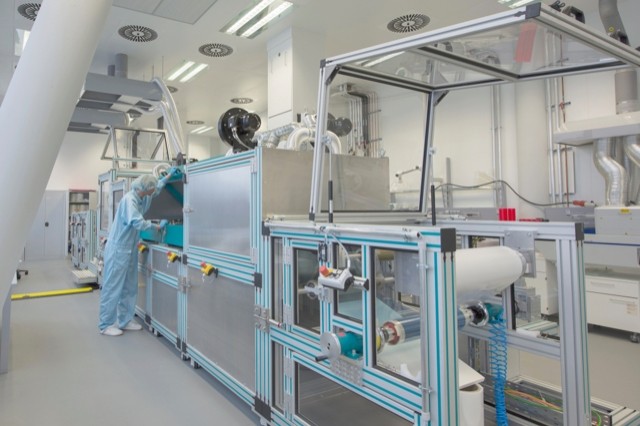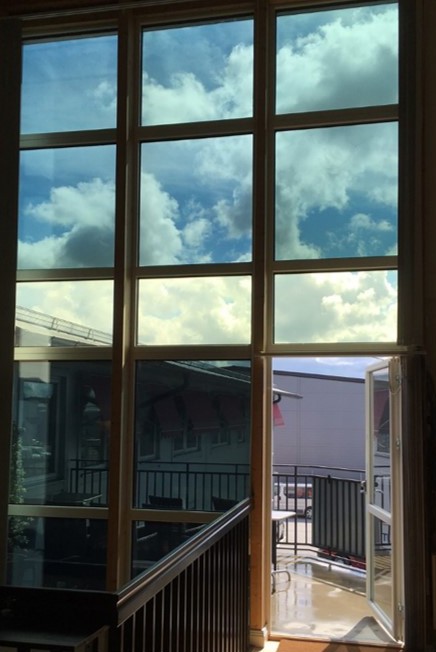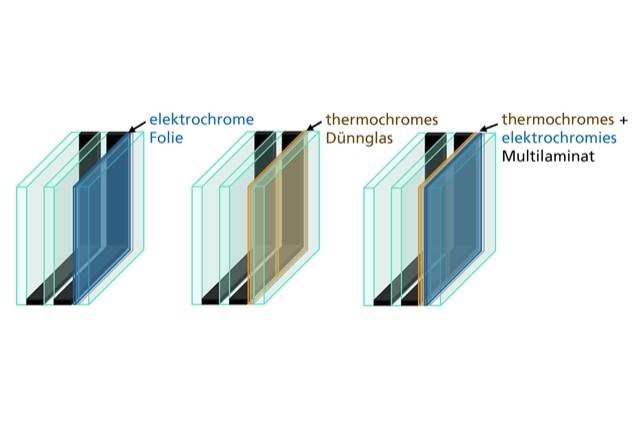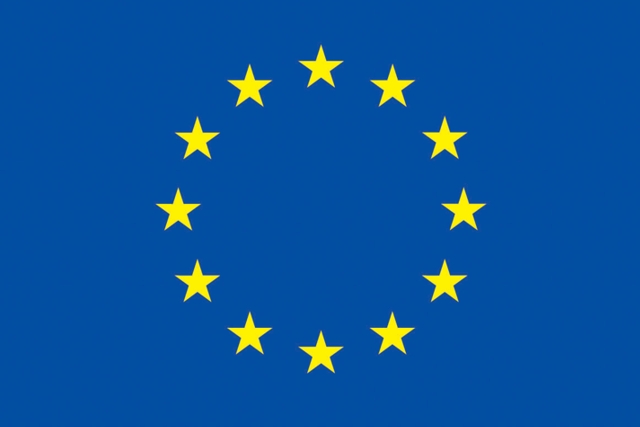Fraunhofer ISC
Switch2save: A leap forward in smart windows and glass façades for highly efficient energy management using novel switching technologies
In modern architecture, large-area glazing is a continuing trend because of its appearance and design variety. Large southwards-oriented windows help to reduce the energy demand for heating in winter. However, large-area glazing may significantly increase the energy demand for cooling and air-conditioning in hot summers. Smart Glass Solutions – such as electrochromic (EC) and thermochromic (TC) windows and glass façades –control the radiation energy transfer with the "touch of a button" and thus can drastically reduce the energy demands for heating and air conditioning of large buildings. In addition, they allow superior indoor lighting comfort in contrast to conventional mechanical window blinds. On 1st October 2019, the EU-funded initiative "Switch2save" was launched to improve the availability and affordability of EC and TC smart glass technologies. The consortium of ten partners from research and industry will demonstrate the energy saving potential of smart glass solutions in two fully-operational buildings. Climate change is a topic now on everyone's lips and climate targets are being discussed at all levels. Solutions such as the use of natural resources for energy generation and energy recovery in existing cycles are currently of high research interest. One building block for a sustainable future is the EU Energy Performance of Buildings Directive that targets a full zero-emission building stock all over Europe before 2050.



Glazing in buildings accounts for up to 60 % of energy transfer through modern building envelopes. In winter, heat is emitted to the outside, while in summer, solar radiation heats the building interior, which increases the demand for air-conditioning and cooling. Large windows and glass façades – a common design element in modern and large buildings – worsen this effect.
Today, mechanical window blinds and jalousies are used to control solar radiation dependent on the time of day, temperature and sunlight intensity. However, they strongly affect (or impair) comfort and light conditions inside the building. In glass façade buildings, such window blinds – if installed at all – disturb the architectural design and require heavy mounts and profiles.
Smart and switchable glass solutions have the potential to replace mechanical window blinds in the future. However, they are currently optimized towards aesthetic requirements and not energy saving, are very expensive and hard to come by. The EU-funded initiative Switch2save aims to overcome these limitations by combining and maturing EC and TC systems to create lightweight Energy Smart Insulating Glass Units (IGUs) suitable for large windows and glass façades. EC switching relies on materials that change their light transmittance by applying a low electrical voltage; TC cells are based on materials that change their infrared reflection properties with increasing temperature.
The Switch2save consortium includes leading universities, research institutes and industries from six EU countries. Within the next four years, the partners will collectively develop a combination of EC and TC cells – with optimized maximum energy saving potential – based on a switchable total energy transmittance (g-value). They will scale the manufacturing technologies for increased availability and cost effectiveness, assess the performance of the innovative IGUs, and demonstrate the heating and cooling energy saving potential and the lighting comfort in two operational buildings in Greece and Sweden.
Project coordinator Dr. John Fahlteich, Fraunhofer FEP, explains the potential of the technology: "Experts estimated that energy demand for air-conditioning and cooling of buildings will more than double by 2050! Furthermore, large glass façade buildings (e.g. shopping centers, airports, office buildings) require as much as 35% more energy for heating and up to five times more energy for cooling than modern buildings with small windows. The Switch2save solution will be able to reduce the total annual heating and cooling energy demand of such large glass buildings by up to 44%. This will be achieved through smart switching protocols based on local, real-time weather and temperature data and the illumination conditions in the building".
The Switch2save EC and TC modules are based on nanoscaled thin film stacks that are applied to plastic webs or ultra-thin glass films by using large area vacuum and atmospheric pressure deposition techniques. The modules have a specific weight of less than one kg per square meter – much less than even a single glass pane in a window. They are easily integrated into IGUs by a lamination step to allow window and glass façade manufacturing with well-established processes – a key requirement for acceptance of the novel technology by construction companies. The integration of wireless switching and standard interfaces directly into the building automation systems will satisfy the needs of building owners and provide maximum energy saving when in operation.
Switch2save will demonstrate the potential in two representative buildings – Greece’s second largest hospital in Athens and an operational office building in Uppsala, Sweden. The Switch2save consortium will replace 50 windows and 200 m² glass façade area with the smart glass solution and will perform a full "before-after" comparison of the energy demand for a one-year cycle in both buildings. The findings will accelerate the widespread implementation of energy smart glass and significantly contribute to the goal of a CO2-neutral building stock in the EU before 2050.
Controlling sunlight at the touch of a button
Researchers at the Fraunhofer ISC have been working successfully for more than 15 years on so-called electrochromic materials and elements for technical applications. These novel materials change their color properties through electric current. Applied as thin layers on transparent, conductive substrates, they can intensify their color at the touch of a button or be completely decolorized.
In the newly launched, European Union-funded project Switch2Save, Fraunhofer ISC is bringing its experience in the production of electrochromic layers on flexible substrates by means of roll-to-roll processes and supporting the research and industry partners in the scaling up of processes and technologies system development. "The advantage of our electrochromic technologies are novel materials that have high color contrast and short switching times. The R2R processability also offers great potential for a future cost reduction in the production of electrochromic elements", Dr. Marco Schott explains, Head of Electrochromic Systems at the Fraunhofer ISC.
When it comes to characterizing the optical and electrochemical properties, the Fraunhofer ISC not only contributes valuable know-how in the Switch2Save project, but also an extensive technical infrastructure. "At the Fraunhofer R&D Center Electromobility Bavaria, which was set up under the umbrella of the Fraunhofer ISC, tests and analyzes for almost all electrochemical issues can be carried out, a benefit for the further development of electrochromic systems, too," continues Schott. The aim of the EU-funded project is the large-scale production of electrochromic and thermochromic switching laminates for use in façade elements and windows.
More information about the Electrochromic Systems Group at Fraunhofer ISC: https://www.fzeb.fraunhofer.de/en/electrochromic-systems.html
More information about the Switch2Save project:
https://cordis.europa.eu/project/rcn/224847/factsheet/de
Project duration: 1st of October 2019 – 30th of September 2023
This project has received funding from the European Union’s Horizon 2020 research and innovation programme under grant agreement No. 869929

Project consortium Switch2Save:
Fraunhofer Institute for Organic Electronics, Electron Beam and Plasma Technology FEP www.fep.fraunhofer.de
Fraunhofer Institute for Silicate Research ISC www.isc.fraunhofer.de
ChromoGenics AB www.chromogenics.com
School of Mechanical Engineering National Technical University of Athens www.mech.ntua.gr/en
University of West Bohemia www.zcu.cz/en
SIA AGL Technologies www.agltechnologies.eu
FASADGLAS BÄCKLIN AB www.fasadglas.se
Vasakronan AB www.vasakronan.se
General State Hospital of Nikaia “Agios Panteleimon” www.nikaia-hosp.gr
VAN ROMPAEY SARA www.e2arc.com/team
AMIRES s.r.o. www.amires.eu
Save the Date
During the conference "pro flex 2019 - Roll-to-roll coating of flexible materials", Dr. John Fahlteich, the Switch2save project coordinator, will be available with other scientists from Fraunhofer FEP to provide information about the project, vacuum-coating possibilities and plant technology. The conference, with focus on a "Technology Cross-Over", offers the possibility to get information about the numerous possibilities of roll-to-roll technologies for film and ultra-thin glass coating on site. "pro flex 2019 - Roll-to-roll coating of flexible materials" will take place from November 4 – 6, 2019. You find more information on the website of Fraunhofer FEP.